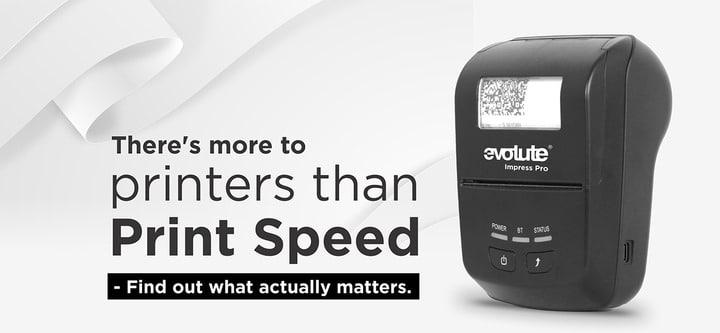In today’s dynamic and digitally driven business environment, operational efficiency is not a luxury—it’s a necessity. Whether you run a retail store, a logistics hub, or a healthcare facility, having a reliable thermal printer can significantly streamline your labelling, billing, or ticketing processes. According to a February 2025 report by MarkWide Research, the global thermal printer market is expected to reach USD 66.3 billion by the end of 2025, driven by increased demand in retail automation and warehousing.
But choosing the right thermal printer can be overwhelming. With the market flooded with a wide range of models boasting various specs, how do you know what truly matters? This guide breaks down the 10 essential factors you should consider before purchasing a thermal printer for your business—backed by the latest trends, stats, and expert insights.
1. Performance and Speed: The Need for Speed
When operations move fast, your printing needs to keep up. Thermal printers today come with blazing print speeds, often reaching up to 300 mm/sec, a critical requirement for high-volume businesses like e-commerce fulfilment centres and supermarkets. A 2025 industry report by Global Growth Insights indicates that over 45% of thermal printers released this year prioritize speed enhancement due to demand in sectors like logistics and healthcare.
The difference in productivity between a 150 mm/sec and a 300 mm/sec model can be staggering when multiplied over thousands of prints. Look for printers that can handle your peak-hour workload without compromising on quality or overheating. In essence, speed should complement your business tempo.
2. Connectivity Options: Stay Connected, Stay Efficient
Gone are the days when USB was your only option. In 2025, connectivity determines workflow flexibility. Printers now offer Wi-Fi, Bluetooth, Ethernet, and mobile device pairing features to accommodate remote work, multiple device access, and app-based operations. According to a March 2025 survey by FutureTech Labs, 30% of businesses switched to thermal printers with wireless connectivity in the past year due to remote working norms and mobile POS systems.
Make sure the printer can connect easily with your POS system, warehouse management software, or enterprise resource planning (ERP) tools. Wireless printing capabilities also reduce clutter and allow for more mobile operations, perfect for businesses that need portability.
3. Durability and Build Quality: Built to Last
Thermal printers often work in harsh environments—think dusty warehouses, bustling kitchens, or high-traffic retail counters. That’s why durability is non-negotiable. Look for printers with industrial-grade casings, internal heat management, and resistance to moisture or grease, depending on your use case.
A 2025 IDC study noted that devices with IP-rated enclosures or reinforced designs reduce downtime by 35% in rugged use environments. If your business operates under pressure—literally or figuratively—a flimsy printer just won’t cut it. Think of durability as a long-term insurance policy for operational continuity.
4. Print Quality and Resolution: Clarity is Key
In barcodes, blurry is bad. In receipts, unclear text confuses. Print resolution is measured in DPI (dots per inch), and 2025, standard models range from 203 to 600 DPI. Higher DPI ensures crisp, legible prints—a must-have if you’re printing small barcodes or detailed logos.
For industries like healthcare, where labels must remain readable for weeks, clarity can directly impact patient safety. According to a recent White Paper from LabelTech Institute (April 2025), 68% of labelling errors in healthcare were linked to poor print resolution or fading ink—a strong case for prioritizing print quality.
5. Energy Efficiency: Go Green, Save Green
Thermal printers don’t use ink or toner, making them more efficient by default. However, newer models take things further by optimizing power consumption during idle and active states. The 2025 GreenTech Index listed thermal printing as one of the top five most energy-efficient business printing methods, especially in applications where short-run printing is frequent.
Brands like APS and Evolute now incorporate ultra-low voltage operation and automatic sleep modes that reduce energy usage by up to 40%. Choosing an energy-efficient printer not only lowers your electricity bills but also supports your corporate sustainability goals—an increasingly important metric for investors and stakeholders alike.
6. Ease of Use and Maintenance: Simplify Operations
Nobody wants a printer that needs a degree in rocket science to operate. User-friendly interfaces, LCD screens, and intuitive software support are vital features in 2025’s business printers. The 2025 Business Tech Survey revealed that 72% of businesses preferred printers with plug-and-play compatibility and tool-free maintenance.
Also, consider maintenance requirements. Some thermal printers come with self-cleaning heads and drop-in roll systems, cutting down on operational downtime and staff training. The more intuitive the device, the faster your team can onboard and the fewer headaches you’ll encounter.
7. Compatibility and Integration: Seamless Workflow
Incompatibility can lead to workflow bottlenecks. Ensure the thermal printer you select can communicate with your existing infrastructure—whether it’s Windows, Linux, Android, or iOS systems. Look for compatibility with popular platforms like Shopify, SAP, QuickBooks, or your warehouse management system.
In 2025, many brands now offer SDKs (Software Development Kits) and APIs for seamless integration. According to DataFlex Reports (Q1 2025), over 60% of thermal printers used in retail are selected based on their ability to plug into multi-platform POS systems, proving that adaptability drives purchasing decisions.
8. Cost Considerations: Balancing Quality and Budget
Don’t be fooled by low upfront costs. The real value of a thermal printer lies in its Total Cost of Ownership (TCO)—which includes maintenance, media cost, lifespan, and operational downtime. A January 2025 report from FinTech Gear found that thermal printers save businesses up to 50% in ongoing operational costs compared to inkjet or laser printers.
Some printers might be slightly more expensive initially but offer better warranties, longer print head life, and lower maintenance costs. Always weigh the long-term savings against the initial investment. Remember what Warren Buffett once said: “Price is what you pay. Value is what you get.”
9. Eco-Friendly Materials: Sustainable Printing
Environmental accountability is no longer optional. With green regulations tightening and customers demanding eco-conscious brands, sustainable printing solutions are crucial. In 2025, manufacturers are innovating with BPA-free, phenol-free, and even recyclable thermal paper.
A recent study from the Sustainability in Tech Forum (March 2025) noted that 22% of businesses shifted to eco-friendly thermal media, reducing waste and improving brand image. Linerless labels—labels without backing paper—are also trending, cutting waste by up to 50%. If sustainability is a brand pillar, your printer should reflect that ethos.
10. After-Sales Support and Warranty: Peace of Mind
Even the best tech can face hiccups. That’s why strong customer support and extended warranty coverage matter. Look for brands with dedicated helplines, online support resources, and nationwide service networks. Some manufacturers now offer predictive maintenance alerts via apps to notify users before a failure occurs.
According to a TechRadar Business Review (April 2025), companies with extended warranties experienced 30% less downtime due to prompt service support. A good support ecosystem can be the difference between a minor inconvenience and a day-long operational halt.
Evolute Fintech Innovations: Powering Smart Printing for Smarter Businesses
As a trusted leader in embedded solutions and financial technology hardware, Evolute Fintech Innovations stands at the forefront of India’s thermal printing evolution. With a strong focus on reliability, efficiency, and scalability, Evolute’s range of thermal printers is purpose-built for mission-critical applications in digital payments, micro-finance, logistics, and retail automation. The company’s advanced printers are designed to support high-speed printing, mobile connectivity, and multi-OS compatibility—ideal for businesses embracing the Bharat Stack and driving financial inclusion. By combining indigenous innovation with global standards, Evolute not only meets today’s dynamic operational demands but also future-proofs your business in the rapidly digitizing economy of 2025 and beyond.
Final Thoughts: Making the Right Pick
Choosing a thermal printer in 2025 is about more than specs. It’s about future-proofing your business, reducing costs, and improving process efficiency. Here’s a quick summary:
Speed & Performance: Match your business throughput.
Connectivity: Look for Wi-Fi, Bluetooth, and cloud integration.
Durability: Choose rugged, industrial-grade models.
Print Quality: High DPI ensures sharp, scannable labels.
Energy Efficiency: Save money and support sustainability.
Ease of Use: Ensure intuitive design and minimal maintenance.
Compatibility: Seamlessly integrate with your ecosystem.
Cost: Don’t just consider price—calculate lifetime value.
Eco-Friendly: Support your brand’s green goals.
Support & Warranty: Choose a trusted brand with great service.
Whether you’re scaling your retail chain or streamlining your warehouse, investing in the right thermal printer could be one of your most impactful decisions this year. In the words of Richard Branson, “Business opportunities are like buses, there’s always another one coming.” But efficiency tools like thermal printers? You need the best one—now.





